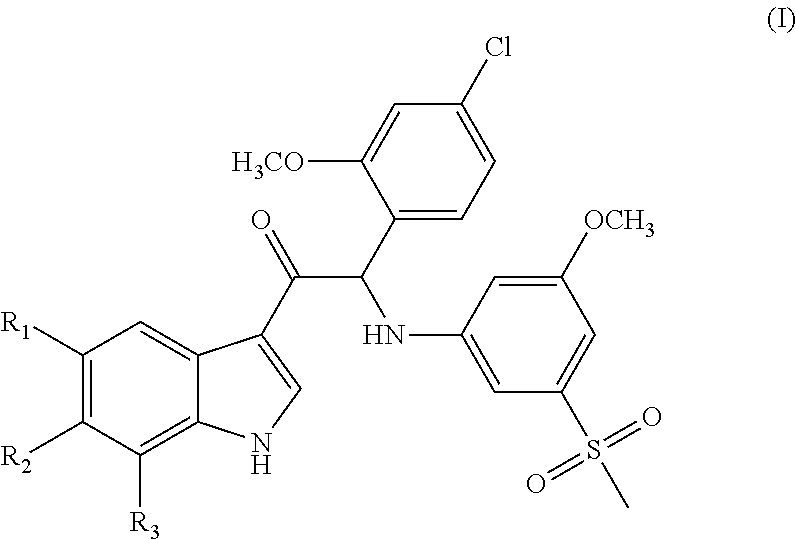Mono- or Di-Substituted Indole Derivatives As Dengue Viral Replication Inhibitors
a technology of dengue virus and indole derivative, which is applied in the field of mono- or di-substituted indole derivatives as dengue virus replication inhibitors, can solve the problems of life-threatening infections in man, dhf has become a leading cause of hospitalization and death among children in endemic regions, and the number of dengue cases is increasing, so as to achieve uniform dosage and facilitate administration.
- Summary
- Abstract
- Description
- Claims
- Application Information
AI Technical Summary
Benefits of technology
Problems solved by technology
Method used
Image
Examples
example 1
Synthesis of 2-(4-chloro-2-methoxyphenyl)-1-(6-fluoro-1H-indol-3-yl)-2-((3-methoxy-5-(methylsulfonyl)phenyl)amino)ethanone (Compound 1) and chiral separation into Enantiomers 1A and 1B
[0068]
[0069]Synthesis of Intermediate 1a:
[0070]2-(4-Chloro-2-methoxyphenyl)acetic acid [CAS 170737-95-8] (5.8 g, 28.9 mmol) was added in small portions to thionyl chloride (50 mL) and the resulting solution was stirred overnight at 60° C. The solvent was concentrated under reduced pressure and co-evaporated with toluene to give 2-(4-chloro-2-methoxyphenyl)-acetyl chloride 1a (6.5 g) as an oily residue that was used without further purification in the next step.
[0071]Synthesis of Intermediate 1b:
[0072]Diethylaluminum chloride 1M in hexane (37.1 mL, 37.1 mmol) was added dropwise at 0° C. to a solution of 6-fluoro-1H-indole [CAS 399-51-9] (3.34 g, 24.76 mmol) in CH2Cl2 (100 mL). After 30 min at 0° C., a solution of 2-(4-chloro-2-methoxyphenyl)acetyl chloride 1a (6.3 g, 28.76 mmol) in CH2Cl2 (100 mL) was a...
example 1.1
Chiral Stability of Enantiomer 1A at pH 7.4
[0094]The chiral stability of Enantiomer 1A (R═OMe) was evaluated by determination of the enantiomeric excess (ee %) after incubation for 24 h and 48 h in a buffered solution at pH 7.4 at 40° C. and 60° C. To assess the influence of the methoxy-substituent of Enantiomer 1A (R═OMe) on the stability against racemization, the chiral stability of Enantiomer 1′A (R═H) was tested under the same conditions. To this end, 5 μM buffered (pH=7.4) solutions of 1A and 1′A were prepared by mixing 25 μL of a 100 μM solution of 1A or 1′A in DMSO with 475 μL aqueous buffer pH 7.4. Samples were taken 24 h and 48 h after incubation at 40° C. and 60° C. The analytical samples were analyzed by Chiral SFC (MS detection) and the chiral purity was expressed as the enantiomeric excess (ee %=% enantiomer A−% enantiomer B). Both Enantiomers 1A and 1′A had a chiral purity of 100% prior to their incubation.
ee %Sampling timepoints (h)CompoundTemperature24481A40° C.10010...
example 2
Synthesis of 2-(4-chloro-2-methoxyphenyl)-1-(6-fluoro-7-methyl-1H-indol-3-yl)-2-((3-methoxy-5-(methylsulfonyl)phenyl)amino)ethanone (Compound 2) and Chiral Separation into Enantiomers 2A and 2B
[0095]
[0096]Synthesis of Intermediate 2a:
[0097]Diethylaluminum chloride 1M in hexane (20 mL, 20.0 mmol) was added dropwise at 0° C. to a solution of 6-fluoro-7-methyl-1H-indole [CAS 57817-10-4] (1.50 g, 10.1 mmol) in CH2Cl2 (45 mL). After 30 min at 0° C., a solution of 2-(4-chloro-2-methoxyphenyl)acetyl chloride (3.30 g, 15.1 mmol, synthesis: see Example 1) in dichloromethane (30 mL) was added slowly. The reaction mixture was stirred at 0° C. for 3 h. 1M Rochelle salt solution (50 mL) was added and the reaction mixture was stirred at room temperature for 1 h. The solids were filtered off and partitioned between EtOAc and 1N HCl. The phases were separated. The aqueous phase was extracted with EtOAc. The organic phases were combined, washed with brine, dried over MgSO4, filtered and concentrated...
PUM
| Property | Measurement | Unit |
|---|---|---|
| Temperature | aaaaa | aaaaa |
| Temperature | aaaaa | aaaaa |
| Temperature | aaaaa | aaaaa |
Abstract
Description
Claims
Application Information
 Login to View More
Login to View More - R&D
- Intellectual Property
- Life Sciences
- Materials
- Tech Scout
- Unparalleled Data Quality
- Higher Quality Content
- 60% Fewer Hallucinations
Browse by: Latest US Patents, China's latest patents, Technical Efficacy Thesaurus, Application Domain, Technology Topic, Popular Technical Reports.
© 2025 PatSnap. All rights reserved.Legal|Privacy policy|Modern Slavery Act Transparency Statement|Sitemap|About US| Contact US: help@patsnap.com



